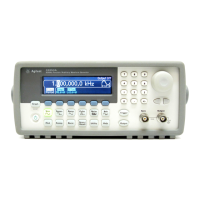63
Chapter 3 Features and Functions
Output Configuration
3
•For FSK, the Sync signal is referenced to the “hop” frequency and is a
square waveform with a 50% duty cycle. The Sync signal is a TTL
“high”
on the transition to the “hop” frequency.
•For frequency sweeps with Marker Off, the Sync signal is a square
waveform with a 50% duty cycle. The Sync signal is a TTL “high” at
the beginning of the sweep and goes “low” at the midpoint of the sweep
.
The frequency of the sync waveform equals the specified sweep time.
•For frequency sweeps with Marker On, the Sync signal is a TTL “high”
at the beginning of the sweep and goes “low” at the marker frequency.
•For a triggered burst, the Sync signal is a TTL “high” when the burst
begins
. The Sync signal
is a TTL “low” at the end of the specified
number of cycles (may not be
the zero-crossing point if the waveform
has an associated start phase). For an
infinite count burst
, the Sync
signal is the same as for a continuous waveform.
•For an externally-gated burst, the Sync signal follows the external
gate signal. However, note that the signal will not go to a TTL “low”
until the end of the last cycle (may not be the zero-crossing point if
the waveform has an associated start phase).
• Front-Panel Operation: Press and select the Sync softkey again
to toggle between “off” and “on”.
• Remote Interface Operation:
OUTPut:SYNC {OFF|ON}
Setting is stored in non-volatile memory

